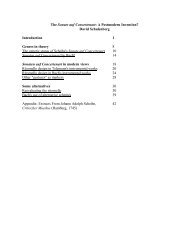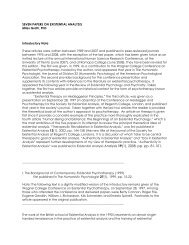download
download
download
You also want an ePaper? Increase the reach of your titles
YUMPU automatically turns print PDFs into web optimized ePapers that Google loves.
18<br />
W. 4: Sources, p. 6<br />
B4 and D1, respectively.<br />
A4 is a single bifolio headed “Violoncello.” with dimensions 21.2 x 34.2 x cm. The title<br />
“Concerto” appears at the left above the first system, followed by “—Nro 2” in a later hand and<br />
lighter ink.<br />
All three components of Thul. 18 are apparently from the collection of Friedrich Wilhelm<br />
von Thulemeier (1750–1811), Prussian ambassador (Gesandter) to Holland and later minister of<br />
state. His father had also been a government minister under King Friedrich Wilhelm I. The<br />
younger Thulemeier bequeathed his collection to the Joachimstaler Gymnasium, from which it<br />
18<br />
subsequently passed to what is now B D. Thulemeier appears to have been a discerning<br />
collector of what are generally accurate copies, and despite serious losses the collection remains<br />
an important source of works by C. P. E. Bach and other Berlin composers, notably Quantz.<br />
Tobias Schwinger has shown that the older Thulemeier probably acquired many copies from the<br />
estate of the Berlin composer and court keyboardist Christoph Nichelmann (1717–62). 19<br />
The three components of Thul. 18 give different versions, particularly of the last movement,<br />
and therefore could not have been used together. Their preservation together may have no<br />
bearing on their origin. Two substantial corrections within A4 are the work of the copyist and do<br />
not appear to have any ramifications for the text. 20<br />
Information abou Thulemeier is from the preface by Robert Eitner to Thematischer Katalog der von<br />
Thulemeier'schen Musikalien-Sammung, edited by Eitner as a Beilage to Monatshefte für Musikgeschichte for<br />
1898–9 (Leipzig: Breitkopf und Härtel, 1899). According to Eitner's introduction, the catalog itself had been<br />
prepared in 1860 by Rudolf Jacobs. Some items in the collection, including source D 3 of W. 5, bear twentiethcentury<br />
stamps indicating a period of holding by the Pädagogische Hochschule Potsdam.<br />
19<br />
Tobias Schwinger, Die Musikaliensammlung Thulemeier und die Berliner Musiküberlieferung in der<br />
zweiten Hälfte des 18. Jahrhunderts (Beeskow: Ortus-Verlag, 2007), 407ff. See Johann Joachim Quantz: Seven Trio<br />
Sonatas, edited by Mary Oleskiewicz (Middleton, Wis.: A-R Editions, 2001), xii, on the unique cembalo-obbligato<br />
versions for Quantz trio sonatas in the Thulemeier collection.<br />
20<br />
Sources: Intermediate Versions<br />
B1: D B Mus. ms. Bach St 618<br />
Five manuscript parts in an unidentified hand, with corrections and revisions by C. P. E.<br />
Bach. Watermark: eagle with crown. Dimensions: 22.4 x 34.9 cm<br />
The parts, all on the same now worn, browning paper, are as follows:<br />
“Cembalo”: 4 nested bifolios = 16 pages (the first and last pages unruled);<br />
“Violino Primo”, “Violino Secondo”, “Viola”, “Basso”: each 2 bifolios = 8 pages (the first<br />
and last unruled, page 1 repeating the part designation).<br />
There is no wrapper or title page; the unruled first page of each part merely repeats the part<br />
The rests after iii.72 were initially followed by a repetition of iii.37–64, and iii.102 was originally<br />
followed by m. 107. The copyist corrected the first error by crossing out the erroneous passage and continuing; the<br />
omitted mm. 103–6 were added on an unused staff at the bottom of the last page, in darker ink but probably the same<br />
hand. Several further errors were later corrected in pencil.















